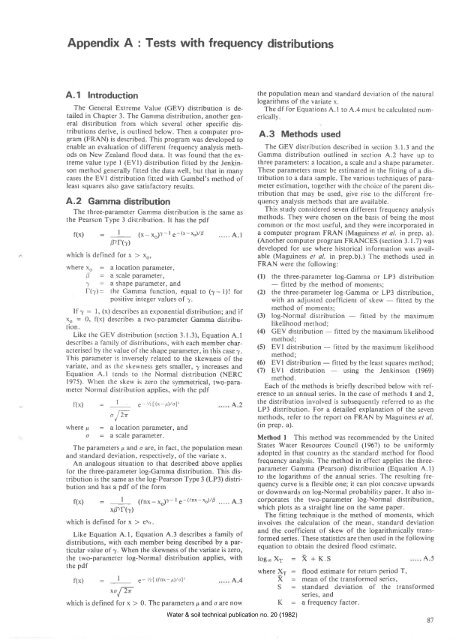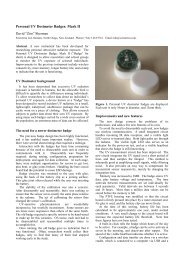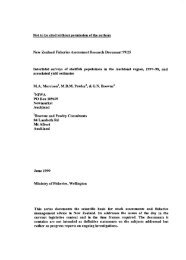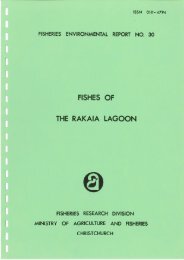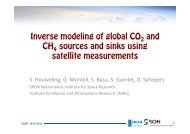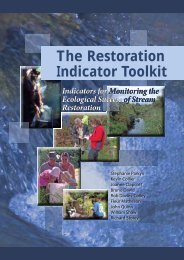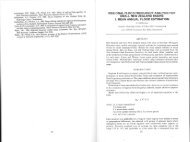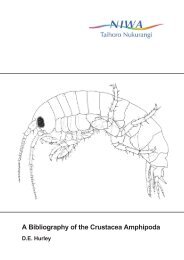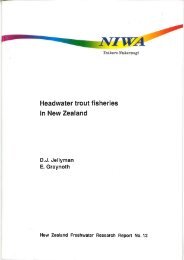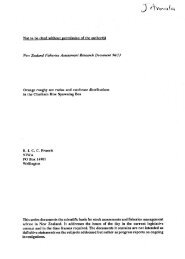WATER & SOIL - These are not the droids you are looking for.
WATER & SOIL - These are not the droids you are looking for.
WATER & SOIL - These are not the droids you are looking for.
You also want an ePaper? Increase the reach of your titles
YUMPU automatically turns print PDFs into web optimized ePapers that Google loves.
Appendix A : Tests with frequency distributions<br />
4.1 Introduction<br />
The General Extreme Value (GEV) distribution is detailed<br />
in Chapter 3. The Gamma distribution, a<strong>not</strong>her general<br />
distribution from which several o<strong>the</strong>r specific distributions<br />
derive, is outlined below. Then a computer program<br />
(FRAN) is described. This program was developed to<br />
enable an evaluation of different lrequency analysis methods<br />
on New Zealand flood data. It was found that <strong>the</strong> extreme<br />
value type I (EVl) distribution fitted by <strong>the</strong> Jenkinson<br />
method generally fitted <strong>the</strong> data well, but that in many<br />
cases <strong>the</strong> EVI distribution l'itted with Gumbel's method of<br />
leasl squ<strong>are</strong>s also gave satisfactory results.<br />
4.2 Gamma distribution<br />
The three-parameter Camma distribution is <strong>the</strong> same as<br />
<strong>the</strong> Pearson Type 3 distribution. It has <strong>the</strong> pdl<br />
f(x) : I (x-xo¡r-le-(x-xo)/li .....A.1<br />
0rr(r)<br />
which is defined <strong>for</strong> x > xo,<br />
where xo<br />
ù_<br />
l)-<br />
I'(r):<br />
a location parameter,<br />
a scale parameter,<br />
a shape parameter, and<br />
<strong>the</strong> Gamma function, equal to ("y- 1)! <strong>for</strong><br />
positive integer values of -y.<br />
lf "y : ¡, (x) describes an exponential distribution; and if<br />
xo = 0, f(x) describes a two-parameter Gamma distribution.<br />
Like <strong>the</strong> CEV distribution (section 3.1.3), Equation A.l<br />
describes a tämily of distributions, with each member characterised<br />
by <strong>the</strong> value of <strong>the</strong> shape parameter, in this case 7.<br />
This parameter is inversely related to <strong>the</strong> skewness of <strong>the</strong><br />
variate, and as <strong>the</strong> skewness gets smaller, "y increases and<br />
Equation A.l tends to <strong>the</strong> Normal distribution (NERC<br />
1975). When <strong>the</strong> skew is zero <strong>the</strong> symmetrical, two-parameter<br />
Normal distribution applies, with <strong>the</strong> pdf<br />
f(x) : I s- /tl(x- pl/ol'<br />
"F<br />
where ¡,r : a location parameter, and<br />
o : ascaleparameter.<br />
A2<br />
The parameters ¡,t and o <strong>are</strong>, in fact, <strong>the</strong> population mean<br />
and standard deviation, respectively, of <strong>the</strong> variate x.<br />
An analogous situation to that described above applies<br />
tbr <strong>the</strong> three-parameter log-Gamma distribution. This distribution<br />
is <strong>the</strong> same as <strong>the</strong> log-Pearson Type 3 (LP3) distribution<br />
and has a pdf of <strong>the</strong> <strong>for</strong>m<br />
f(x) : I (l'nx- xo)?- I e-(r)nx-xo)/B ..... 4.3<br />
x0zf(r)<br />
which is defined <strong>for</strong> x > e"n.<br />
Like Equation A. I, Equation 4.3 describes a family of<br />
distributions, with each member being described by a particular<br />
value of 'y. When <strong>the</strong> skewness of <strong>the</strong> variate is zero,<br />
<strong>the</strong> two-parameter log-Normal distribution applies, with<br />
<strong>the</strong> pdf<br />
f(x) : I s-<br />
xoF<br />
/,1 (t'nx- p\/ øl'<br />
A4<br />
which is defined <strong>for</strong> x > 0. The parameters p and r <strong>are</strong> now<br />
<strong>the</strong> population mean and standard deviation of <strong>the</strong> natural<br />
logarithms of <strong>the</strong> variate x.<br />
The df <strong>for</strong> Equations A.t to 4.4 must be calculated numerically.<br />
A.3 Methods used<br />
The GEV distribution described in section 3.1.3 and <strong>the</strong><br />
Camma distribution outlined in section 4.2 have up to<br />
three parameters: a location, a scale and a shape parameter.<br />
<strong>These</strong> parameters must be estimatcd in <strong>the</strong> fitting ol a distribution<br />
to a data sample. The various techniques of parameter<br />
estimation, toge<strong>the</strong>r with <strong>the</strong> choice of <strong>the</strong> p<strong>are</strong>nt distribution<br />
that may be used, give rise to <strong>the</strong> dilferent frequency<br />
analysis methods that <strong>are</strong> available.<br />
This study considered seven different frequency analysis<br />
methods. They were chosen on <strong>the</strong> basis of being <strong>the</strong> most<br />
common or <strong>the</strong> most useful, and <strong>the</strong>y were incorporated in<br />
a computer program FRAN (Maguiness ef a/. in prep. a).<br />
(A<strong>not</strong>her computer program FRANCES (section 3.1.7) was<br />
developed <strong>for</strong> use where historical in<strong>for</strong>mation was available<br />
(Maguiness e! al. in prep.b).) The methods used in<br />
FRAN were <strong>the</strong> lollowing:<br />
(1) <strong>the</strong> three-parameter log-Camma or LP3 distribution<br />
fitted by <strong>the</strong> method of moments;<br />
(2', -<br />
<strong>the</strong> three-parameter log-Gamma or LP3 distribution,<br />
with an adjusted coefficient ol skew fitted by <strong>the</strong><br />
method of moments'<br />
-<br />
(3) log-Normal distribution -<br />
fitted by <strong>the</strong> maximum<br />
likelihood method;<br />
(4) GEV distribution -<br />
fitted by <strong>the</strong> maximum likelihood<br />
method;<br />
Water & soil technical publication no. 20 (1982)<br />
(5) EVI distribution fitted by <strong>the</strong> maximum likelihood<br />
-<br />
method;<br />
(ó) EVI distribution -<br />
fitted by <strong>the</strong> least squ<strong>are</strong>s method;<br />
(7) EVI distribution -<br />
using <strong>the</strong> Jenkinson (1969)<br />
method.<br />
Each of <strong>the</strong> methods is briefly described below with reference<br />
to an annual series. In <strong>the</strong> case of methods I and 2,<br />
<strong>the</strong> distribution involved is subsequently referred to as <strong>the</strong><br />
LP3 distribution. For a detailed explanation of <strong>the</strong> seven<br />
methods, refer to <strong>the</strong> report on FRAN by Maguiness e/ a/.<br />
(in prep. a).<br />
Method I This method was recommended by <strong>the</strong> United<br />
States Water Resources Council (1967) to be uni<strong>for</strong>mly<br />
adopted in that country as <strong>the</strong> standard method <strong>for</strong> flood<br />
frequency analysis. The method in effect applies <strong>the</strong> threeparameter<br />
Gamma (Pearson) distribution (Equation A.l)<br />
to <strong>the</strong> logarithms of <strong>the</strong> annual series. The resulting frequency<br />
curve is a flexible one; it can plot concave upwards<br />
or downwards on log-Normal probability paper. It also incorporates<br />
<strong>the</strong> two-parameter log-Normal distribution,<br />
which plots as a straight line on <strong>the</strong> same paper.<br />
The fitting technique is <strong>the</strong> method of moments, which<br />
involves <strong>the</strong> calculation of <strong>the</strong> mean, standard deviation<br />
and <strong>the</strong> coefficient of skew of <strong>the</strong> logarithmically trans<strong>for</strong>med<br />
series. <strong>These</strong> statistics <strong>are</strong> <strong>the</strong>n used in <strong>the</strong> following<br />
equation to obtain <strong>the</strong> desired flood estimate.<br />
log'oX1 : X +K.S<br />
A5<br />
where X1 : flood estimate <strong>for</strong> return period T,<br />
X : mean of <strong>the</strong> trans<strong>for</strong>med series,<br />
S : standard deviation of <strong>the</strong> translormed<br />
series, and<br />
K : afrequencyfactor.<br />
87


